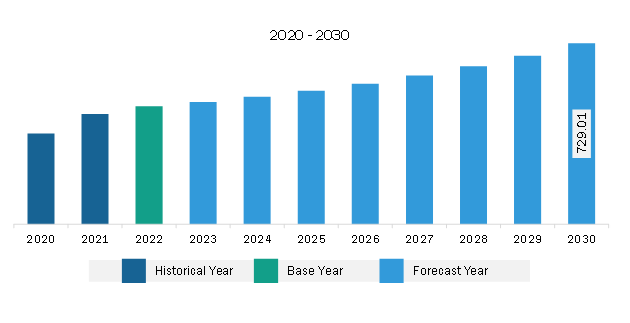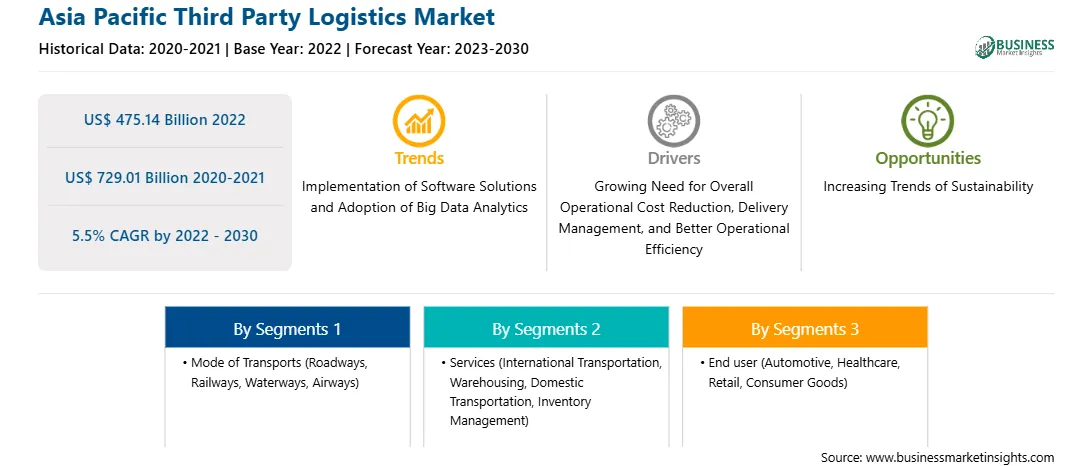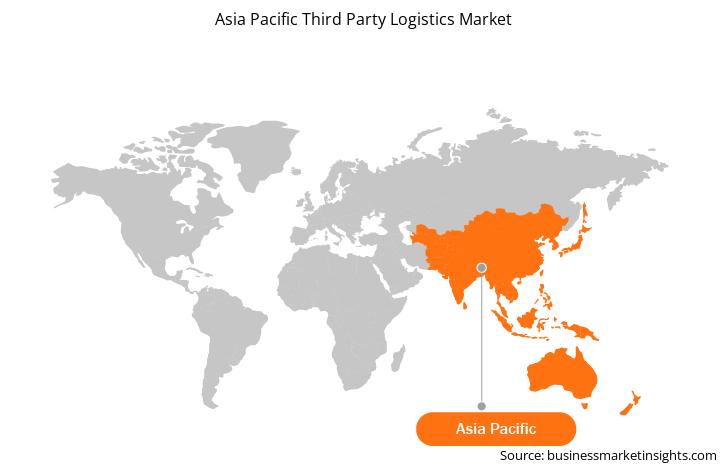The Asia Pacific third party logistics market was valued at US$ 475.14 billion in 2022 and is expected to reach US$ 729.01 billion by 2030; it is estimated to register a CAGR of 5.5% from 2022 to 2030.
Many large and medium-sized organizations are taking initiatives to optimize their business processes to reduce carbon footprints. The transportation and logistics sector is among the major contributors to carbon emissions, accounting for approximately 27% of the total emissions. Many third-party logistics firms are helping shippers improve mobility by planning more effective routes, using environmentally friendly modes of transportation, and occupying key places. Third-party logistics providers such as Borderline help reduce carbon emissions during the transportation stage of distribution by raising the fill rate per transport unit per tank of fuel, using higher-capacity vehicles, and performing routine maintenance of transport vehicles. While historically, the engineering of packing technologies has prioritized economic effectiveness and secure shipping over sustainability, many third-party logistics providers are rapidly moving to eco-friendly packaging to reduce their environmental impact. As recycled waste is used in the creation of eco-friendly packaging, fewer harmful resources are used, which lower overall carbon emissions. Initiatives like these that focus on reducing carbon footprints are aligning with organizations' business strategy, ultimately driving the third-party logistics industry. In addition, governments of developed nations are compelling organizations to adopt greener practices. As a result, many manufacturing companies are searching for third-party logistics providers that have introduced eco-friendly efforts in light of this trend. Some of the practices involve minimizing waste production, lowering the carbon footprint of transportation, and adopting recyclable or environmentally friendly packaging.
Continuously growing economies and penetration of e-commerce are driving the market. Owing to growth in the industrial, manufacturing, and agriculture sectors in developing economies such as India, Malaysia, and Singapore, the logistics activities in the region are increasing. Further, government initiatives to promote the logistics sector and develop infrastructure are some supporting factors for the market growth. In 2022, the Asian Development Bank (ADB) authorized a $ 250 million policy-based loan to help the Indian government's goal of strengthening the country's logistics infrastructure and lowering costs. The factors mentioned above are anticipated to drive the market in the near future. With factors such as favorable government regulations, excellent road, rail, and transportation infrastructure, a vast network of warehousing and storage facilities, and a strong IT infrastructure, China is progressively emerging as one of the world's strongest players in logistics and transportation. A new era in China's economic history has begun as a result of the country's e-commerce sector's rapid growth. More than 38% of China's GDP was derived from its e-commerce sector. Furthermore, nearly one-fourth of Chinese goods were available online in 2020. This amount is significantly higher than the global average of 18%. Last year, more than half of all retail e-commerce sales worldwide were made with Chinese goods. Furthermore, owing to digitalization and automation in the industry, the nation's overall logistics sector has shown notable development. Thus, due to the factors mentioned above, the country's overall adoption of 3PL services has increased significantly.

Strategic insights for the Asia Pacific Third Party Logistics provides data-driven analysis of the industry landscape, including current trends, key players, and regional nuances. These insights offer actionable recommendations, enabling readers to differentiate themselves from competitors by identifying untapped segments or developing unique value propositions. Leveraging data analytics, these insights help industry players anticipate the market shifts, whether investors, manufacturers, or other stakeholders. A future-oriented perspective is essential, helping stakeholders anticipate market shifts and position themselves for long-term success in this dynamic region. Ultimately, effective strategic insights empower readers to make informed decisions that drive profitability and achieve their business objectives within the market.

| Report Attribute | Details |
|---|---|
| Market size in 2022 | US$ 475.14 Billion |
| Market Size by 2030 | US$ 729.01 Billion |
| Global CAGR (2022 - 2030) | 5.5% |
| Historical Data | 2020-2021 |
| Forecast period | 2023-2030 |
| Segments Covered |
By Mode of Transports
|
| Regions and Countries Covered | Asia-Pacific
|
| Market leaders and key company profiles |
The geographic scope of the Asia Pacific Third Party Logistics refers to the specific areas in which a business operates and competes. Understanding local distinctions, such as diverse consumer preferences (e.g., demand for specific plug types or battery backup durations), varying economic conditions, and regulatory environments, is crucial for tailoring strategies to specific markets. Businesses can expand their reach by identifying underserved areas or adapting their offerings to meet local demands. A clear market focus allows for more effective resource allocation, targeted marketing campaigns, and better positioning against local competitors, ultimately driving growth in those targeted areas.

The Asia Pacific third party logistics market is categorized into mode of transports, services, end user, and country.
Based on mode of transports, the Asia Pacific third party logistics market is segmented into roadways, railways, waterways, and airways. The roadways segment held the largest market share in 2022.
In terms of services, the Asia Pacific third party logistics market is segmented into international transportation, warehousing, domestic transportation, inventory management, and others. The domestic transportation segment held the largest market share in 2022.
Based on end user, the Asia Pacific third party logistics market is segmented into automotive, healthcare, retail, consumer goods, and others. The others segment held the largest market share in 2022.
By country, the Asia Pacific third party logistics market is segmented into Australia, China, India, Japan, South Korea, and the Rest of Asia Pacific. China dominated the Asia Pacific third party logistics market share in 2022.
C H Robinson Worldwide Inc, DB Schenker, DSV AS, GEODIS SA, Kuehne + Nagel International AG, Nippon Express Co Ltd, Sinotrans Ltd, and United Parcel Service Inc are among the leading companies operating in the Asia Pacific third party logistics market.
The Asia Pacific Third Party Logistics Market is valued at US$ 475.14 Billion in 2022, it is projected to reach US$ 729.01 Billion by 2030.
As per our report Asia Pacific Third Party Logistics Market, the market size is valued at US$ 475.14 Billion in 2022, projecting it to reach US$ 729.01 Billion by 2030. This translates to a CAGR of approximately 5.5% during the forecast period.
The Asia Pacific Third Party Logistics Market report typically cover these key segments-
The historic period, base year, and forecast period can vary slightly depending on the specific market research report. However, for the Asia Pacific Third Party Logistics Market report:
The Asia Pacific Third Party Logistics Market is populated by several key players, each contributing to its growth and innovation. Some of the major players include:
The Asia Pacific Third Party Logistics Market report is valuable for diverse stakeholders, including:
Essentially, anyone involved in or considering involvement in the Asia Pacific Third Party Logistics Market value chain can benefit from the information contained in a comprehensive market report.